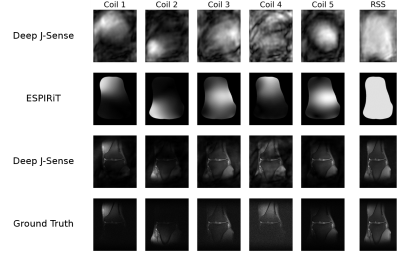Marius Arvinte1, Sriram Vishwanath1, Ahmed H Tewfik1, and Jonathan I Tamir1,2,3
1Electrical and Computer Engineering, The University of Texas at Austin, Austin, TX, United States, 2Diagnostic Medicine, Dell Medical School, The University of Texas at Austin, Austin, TX, United States, 3Oden Institute for Computational Engineering and Sciences, The University of Texas at Austin, Austin, TX, United States
1Electrical and Computer Engineering, The University of Texas at Austin, Austin, TX, United States, 2Diagnostic Medicine, Dell Medical School, The University of Texas at Austin, Austin, TX, United States, 3Oden Institute for Computational Engineering and Sciences, The University of Texas at Austin, Austin, TX, United States
We introduce a deep learning-based accelerated MRI reconstruction method that unrolls an alternating optimization and jointly estimates the image and coil sensitivity maps. We show competitive results against state-of-the-art methods and faster convergence in poor channel conditions.

Block diagram of the
approach. (a) Inside each unrolling step, the pair of variables is updated in
an alternating fashion with M steps of CG applied to each variable. The red
blocks represent the learnable parameters of Deep J-Sense and are shared across
unrolls. The numbers in parentheses corresponding to the four update steps in
the text. (b) N unrolls are applied starting from initial values. At each step,
the gradient of the loss term is back-propagated to the trainable parameters and
an update is performed.

Examples of estimated
sensitivity maps and reconstructed coil images output by our method after N = 6
unrolls for a validation sample with R = 4. The first five columns show specific
coils and the last columns shows the RSS image obtained from all 15 coils. The
first row shows the estimated sensitivity maps, obtained by zero-padding and
IFFT of the estimated frequency-domain kernel. The second row shows the
sensitivity maps estimated using the auto-ESPIRiT algorithm. The
third row shows the reconstructed coil images.
The fourth row shows the ground truth (fully-sampled) coil images.
